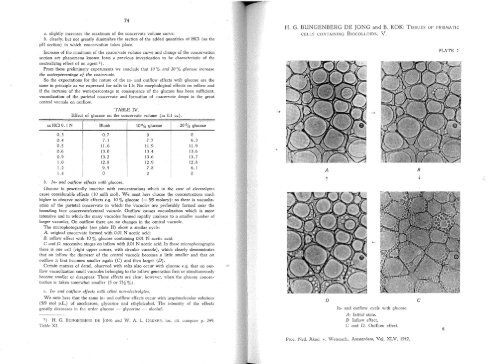V - DWC
V - DWC
V - DWC
You also want an ePaper? Increase the reach of your titles
YUMPU automatically turns print PDFs into web optimized ePapers that Google loves.
74<br />
a. slightly increases the maximum of the coacervate volume curve;<br />
b. c1early, but not greatly diminishes the seetion of the added quantities of Hel (so the<br />
pH seetion) in which eoacervation takes plaee.<br />
" '<br />
Irerease of the maximum of the coacervate volu'me curvE; and change of the coaeervation<br />
section ar'e phenomena known form a previous investigation to be characteristic of thc<br />
neutralizing effect of an agent 1) .<br />
Prom these preliminary e~periments we conclude that 10 % and 20 % glucose increasc<br />
the waterpe:rcentage ot the coacet'vate.<br />
So the expectations for the nature of the in- and outflow effects wtih glucose are the<br />
same in principle as we expressed for salts in I b: No morphological effe cts on inflow and<br />
jf the inerease of the waterpercentage in consequence of the glucose has been suffident,<br />
vacuolization of the parietal coacervate and formation of coacervate drops in the great<br />
central vacuole on outflow.<br />
TABLE IV.<br />
Effect of glucose on the coacervate volume ,(in 0.1 cc).<br />
~,--=+ --<br />
ecHel 0.1 N<br />
l<br />
Blank 10 % glucose 20% glucose<br />
0.3 0.7 0 0<br />
0.4 7.3 7.7 6.3<br />
0.5 11.6 11.9 11.9<br />
0.6 13.0 13.4 13.6<br />
0.9 13.2 13.6 13.7<br />
1.0 12.8 12.9 12.8<br />
1.2 9.5 7.8 6.1<br />
1.4 0 0 0<br />
b. In- and outflow effects w~th glucose.<br />
Glucose is practically inactive with concentrations which in the case of electrolytes<br />
cause considerable effects (10 milli mol). We mu'st hère choose the concentrations much<br />
higher to observe notabIe effects e.g. 10 % glucose (= 519 molary): so there is vacuoiizaticm<br />
of the parietal. coaeervatein which the vacuoles are preferably formed near the<br />
bounding face coacerv~te/central vacuole. Outfloweauses vaeuolization which is more<br />
intensive and in which the many vaeuoles formed rapidly coalesee to a smaller number of<br />
larger vaeuoles. On outflow there are no changes in the centra 1 vacuole.<br />
The microphotographs (see plate lI) show a similar eycle:<br />
A. original eoacervate formed with 0.01 N acetic acid;<br />
B. in flow effect with 10 % glucose containing 0.01 N acetie acid;<br />
e and D. successive stages on inflow with 0.01 N acetie acid. In these microphotographs<br />
there is one eell (light upper corner, with circular vacuole), which c1early demonstrates<br />
that on inflow the diameter of the central vacuole becomes a little smaller and that on<br />
out flow it first beeomes smaller again (C) and then largel' (D).<br />
eertain matters of detail, observed with salts al80 occur with glucose e.g. that on outflow<br />
vacuolization small vaCtlOles belonging to the inflow generation first or simultaneously<br />
become smaller or disappear. These effects are clear, however, when 'the glucose con eentration<br />
is taken somewhat smaller (5 or 2Yz %).<br />
H. G. BUNGENBERG DE JONG and B. KOK: TISSUES OF PRISMATIC<br />
CELLS CONTAININO BIOCOLLOIDS. V.<br />
A<br />
t<br />
B<br />
-+-<br />
PLATE 2<br />
c. Irv and outflow etfects with other non-el.ectrolytes.<br />
We note here that the same in- 3nd olltflow effe ets occur with aequ'Îlnolecular solutiol1s<br />
(5/9 mol p.L.) of saccharose, glycerine and ethylalcohol. The intensity of the effects<br />
grcatly decreases in the order glucose -- glycerine - alcohol.<br />
:1) H. G. BUNGENBEFO DE JONG and W. A. L. DEKKEH, loc. cito compare p. 249,<br />
Table XI.<br />
o<br />
In- and autflow cycle with glucose.<br />
A: Initial state.<br />
B: lnflow effect.<br />
C and D: Outflow effect.<br />
C<br />
Proc. Ned. Akad. v. Wetenseh., Amsterdam, Vol. XLV, 1942.

















